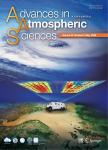版权所有:内蒙古大学图书馆 技术提供:维普资讯• 智图
内蒙古自治区呼和浩特市赛罕区大学西街235号 邮编: 010021

作者机构:State Key Laboratory of Numerical Modeling for Atmospheric Sciences and Geophysical Fluid Dynamics Institute of Atmospheric Physics Chinese Academy of Sciences Beijing 100029 Institute of Meteorology PLA University of Science and Technology Nanjing 211101 State Key Laboratory of Numerical Modeling for Atmospheric Sciences and Geophysical Fluid Dynamics Institute of Atmospheric Physics Chinese Academy of Sciences Beijing 100029 China Meteorological Administration Beijing 100081 State Key Laboratory of Numerical Modeling for Atmospheric Sciences and Geophysical Fluid Dynamics Institute of Atmospheric Physics Chinese Academy of Sciences Beijing 100029
出 版 物:《Advances in Atmospheric Sciences》 (大气科学进展(英文版))
年 卷 期:2005年第22卷第2期
页 面:260-270页
核心收录:
学科分类:07[理学] 070601[理学-气象学] 0706[理学-大气科学]
基 金:This work was jointly supported by the National Key Basic Research and Development project of China under Grant No.2004CB418304 the National Natural Science Foundation of China under Grant Nos.40233031 and 40221503
主 题:AREM eastern China middle cloud divergence inversion
摘 要:Based on the simulations of cloud features in February 2001 by the regional numerical weather prediction model-Advanced Regional Eta-coordinate Model (AREM), the dynamic and thermodynamic conditions for middle cloud formation over eastern China are studied. Diagnostic analysis partly confirms the previous suggestion that the middle stratiform clouds downstream of the Tibetaan Plateau are maintained by the frictional and blocking effects of the plateau. In addition, it is found that the temperature inversion at plateau height over eastern China generated by the warm air advected from the plateau provides a favorable thermodynamic condition for middle clouds. Both diurnal variations of the mid-level divergence and the inversion over eastern China, which are determined by the atmospheric boundary activity over the Tibetan Plateau, dominate the cloud diurnal cycle. The middle cloud amount decreases and the cloud top falls in the daytime, but reverses at night. The comparison of cloud features between the simulations and the observations also proves that the AREM can well capture the distinctive continental stratiform cloud features downstream of the Tibetan Plateau.